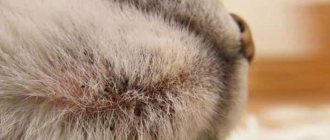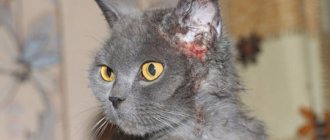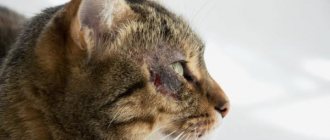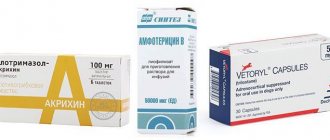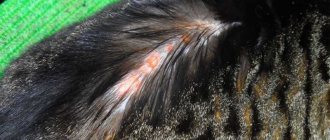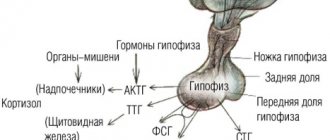Causes of dermatitis Symptoms Diagnosis Treatment Doctor's recommendations Malassezia pachydermatis
is a fungus in cats that lives on the skin of all healthy animals and is an opportunistic microflora. That is, under normal conditions, Malassezia does not cause any harm to the animal, coexisting with other microflora, but when conditions favorable for the proliferation of the fungus arise, it can begin to actively grow, affecting the skin, causing itching and an unpleasant odor. Under normal conditions, it is not active on a healthy animal.
Malassezia loves warmth and humidity, so the following areas of a cat’s body are most often affected by it:
- external auditory canal,
- folds of skin on the abdomen, in the armpits, inguinal fold,
- interdigital space,
- cavity of the paraanal glands.
Causes of dermatitis
It is impossible to become infected with Malassezia, since it is normally found on the skin of any healthy cat, so the cause of fungal dermatitis is caused by excessive, pathogenic proliferation of the fungus. A signal for its reproduction may be a decrease in the protective properties of the cat’s skin under the influence of various factors - allergies, decreased immunity, flea and tick bites, constant exposure to a humid environment (usually this is typical for stray cats that live in basements during the cold season), etc.
Establishing diagnosis
To successfully treat feline Malassezia, it is necessary to make a correct diagnosis. This can only be done in a clinical setting, taking into account the history, clinical examination and laboratory results.
A scraping is taken from the animal at the border of the affected and healthy skin. The discovery of a large number of Malassezia yeast spores in it suggests that this particular pathogen is the cause of the development of the disease. To accurately determine the species of the pathogen, cultures are done on nutrient media.
Laboratory tests are required to make a diagnosis
When the diagnosis of Malassezia in a cat is confirmed, the veterinarian determines the root cause that led to a decrease in immunity and develops a comprehensive treatment.
Diagnostics
To diagnose a cat with Malassezia dermatitis, a dermatologist carefully examines the animal and takes cytology from its skin - prints from problem areas using adhesive tape. The microflora collected on the tape is examined under a microscope, with the help of which it is already possible to say for sure whether the cat has a fungus on the skin, estimate their number and the presence of a secondary bacterial infection.
It must be remembered that the presence of fungus in cats is always secondary, fungal dermatitis develops against the background of other pathologies, therefore, when conducting diagnostics, it is necessary to identify the primary cause that caused the pathological proliferation of the fungus.
Most often, the development of Malassezia dermatitis occurs against the background of various allergies in cats. To diagnose allergies, preventive treatments against ectoparasites (fleas) are carried out, and an elimination diet is prescribed. Allergy to flea saliva is the most common type of allergy; for hypersensitivity to occur, it is not necessary that the animal be densely populated with fleas - it is enough that fleas live behind baseboards or in ventilation, and bite only occasionally. Unfortunately, they are found even in new houses and renovated apartments. Food allergies are a much rarer phenomenon and can currently only be determined in cats using an elimination diet. If an allergy to the saliva of ectoparasites and a food allergy are not confirmed, and all other possible causes of itching are excluded, a diagnosis of atopic allergy can be made (that is, an allergy to any component of the external environment - dust, pollen, and so on).
Video of taking a pap smear from a cat to diagnose Malassezia dermatitis.
Provoking factors
Factors contributing to the development of Malassezia in cats include:
- hereditary diseases that cause a low level of production of immune cells;
- infectious diseases;
- malignant tumors;
- the presence of intestinal helminths, protozoa, and ectoparasites;
- genitourinary infections;
- hormonal disorders;
- allergic reactions;
- skin lesions;
- injuries and mechanical damage to the skin;
- severe post-traumatic and postoperative period;
- poisoning;
- long-term or ill-informed antibiotic therapy;
- exhaustion.
Most often, Malassezia otitis media begins to develop first, since the skin in the ears is softer and more sensitive than on other parts of the body. In addition, it is in the ear canal that the most comfortable conditions are created for the proliferation of yeast and other pathogenic microflora that can accompany this disease.
Treatment
Depending on the extent of the lesions, the animal’s symptoms, and the presence of itching, complex treatment may be required, which includes:
- Antibiotics
Antibiotic therapy is prescribed to fight the bacterial infection that grows on Malassezia-affected skin. The drugs are prescribed for a long time and are not discontinued without the decision of a dermatologist.
- Shampoos and external skin treatments
The cat may be given medicated shampoo baths, ear lotions, or topical treatments with special solutions (for example, 1% or 2% chlorhexidine) several times a day to prevent the growth of pathogenic microflora.
- Antihistamines
Antipruritic medications are prescribed to animals with severe itching to prevent them from licking or scratching problem areas.
- Elizabethan collar and blanket
To limit the cat from licking and scratching, it may be recommended that she wear an Elizabethan collar or blanket.
- Systemic antifungal drugs
Oral antifungal drugs are prescribed to cats only for very massive Malassezia lesions. They try to use them rarely, since cats are very sensitive to these substances and may not tolerate them well. Before systemic antifungal therapy is prescribed, the cat must undergo a series of tests to confirm normal liver function.
In addition, malassezia is always a secondary disease and a dermatologist will need to determine the primary cause. The primary cause of malasseziasis may be flea infestation, skin parasites, atopic dermatitis, or food allergies. At the same time, the cat can be prescribed treatment for ectoparasites and an elimination diet.
Prevention
In order to prevent dermatitis from occurring in a cat, it is necessary, first of all, to provide high-quality care. Nutrition plays an important role. Low-quality products can not only provoke allergies, but also simply weaken the animal’s immunity, making it defenseless against disease.
Grooming is also of great importance. This is especially true for long-haired breeds. Regular bathing helps prevent the development of dermatitis. Brushing also has a positive effect. Grooming not only allows you to remove dead hair, but also serves as a kind of massage for the animal’s skin.
Grooming - combing out fur
Deworming will allow the animal to avoid infection with parasites. Another important factor is limiting the cat’s contact with unfamiliar, especially stray animals.
To avoid the occurrence of dermatitis, cats need good living conditions. And timely diagnosis will allow you to start treatment on time, and, if possible, prevent the disease.
Still have questions? Welcome to the comments section.
As for prevention, it is very simple:
- love your animal;
- do not give him junk food;
- take care of your pet in every possible way.
The following measures are used to prevent the development of dermatitis in cats:
- regular treatment of your pet against external and internal parasites;
- vaccine prevention of infectious diseases;
- limiting the cat’s contact with homeless relatives to reduce the risk of transmission of infectious and parasitic diseases;
- timely detection and treatment of chronic diseases;
- use of high quality balanced food in feeding the cat;
- monitoring the condition of the cat’s skin;
- preventive examinations by a veterinarian.
Dermatitis is characterized by the presence of inflammatory changes in the skin, which can be caused by a number of different diseases, so only an experienced veterinarian can establish an accurate diagnosis and rid the cat of the disease. Therapy for dermatitis is a long, painstaking work that requires patience and observation from the cat owner.
Treatment of dermatitis without the participation of a veterinarian using local therapy in most cases will improve the skin condition only temporarily, and in the future it will result in a relapse of dermatitis. In a number of diseases, for example, infectious or autoimmune diseases, the main threat is not dermatitis.
Recommendations
Animals suffering from malasseziasis are advised to periodically bathe with a special shampoo. You should monitor the folds of the skin, the external auditory canal, the interdigital areas, and if brown plaque appears, begin local treatments, since local treatment carried out on time can minimize the intake of tablets and medications for the cat.
You should not keep the animal constantly in a humid environment; you need to monitor its diet (if a food allergy is diagnosed). To protect your cat from fungus, you need to regularly treat the animal against fleas and other ectoparasites.
Signs of the disease
The main symptoms of Malassezia in a domestic cat are:
- itching;
- redness of certain areas of the skin;
- peeling;
- hair loss;
- discharge of serous foul-smelling exudate;
- the appearance of alopecia.
Malassezia fungus affects your pet's skin and mucous membranes
The first sign that may indicate that a cat is developing Malassezia is the appearance of redness around the ear, on the face, belly, groin, between the toes and around the anus. The cat begins to scratch and lick the areas affected by the Malassezia fungus. This aggravates the development of pathology, as scratches form on the skin, into which pyogenic microflora gets trapped.
Gradually, the skin folds thicken, the upper layer of the dermis becomes rough and flakes off along with the fur. In these places, bald patches remain, on which small pimples are clearly visible. As a result of damage to the hair follicles, their functioning is disrupted, serous exudate is released, which glues the hairs together and emits a rather unpleasant odor.
Malassezia otitis in cats begins with the appearance of a dark brown plaque on the inner surface of the ear and in the ear canal. According to the clinical picture, the symptoms are similar to otodectosis, but the characteristic difference is the presence of an unpleasant sour odor and copious discharge of serous exudate. The cat's behavior changes greatly. The animal becomes lethargic, often tilts its head, shakes it, and sometimes hits its ear with its paw.
If left untreated, Malassezia in cats acquires a generalized form and affects the mucous membranes and internal organs of the pet. At this stage of the disease, specific treatment is required, which can only be prescribed by a qualified veterinarian.
How contagious is the fungus in Malassezia?
When doctors use the term “malassezia,” they mean a fungal organism of the yeast species. It is slightly convex in shape and has a cylindrical structure, smooth, soft, loose, and small (if translated into microns, it is two and a half microns). Looking at it, you may think that you are seeing an ordinary nut. Malassezia crops are characterized by an unusual smell with a “fruity” tint.
When you see someone with Malassezia dermatitis, you don’t have to run away in fear or hide your pet away. The idea that Malassezia fungus is contagious is completely false. Since it is one of the components of the microflora, which tends to be present on the epithelial tissue of the animal throughout its life.
In everyday life, the fungus causes absolutely no harm. Excessively fast and large reproduction begins after any incidents that create an excellent environment for this. Most often this is provoked by various changes in the microclimate of the skin (humidity, warmth, advanced inflammation).
Not all dogs are susceptible to this type of disease. For example, according to statistics, most dogs with Malassezia dermatitis are those with folds.
If you can’t catch a disease, then how do you get it? Among the primary factors that provoke the appearance of dermatitis, the most common are the presence of allergic reactions in the animal, disturbances at the hormonal level, weakening of the immune system, and others.
